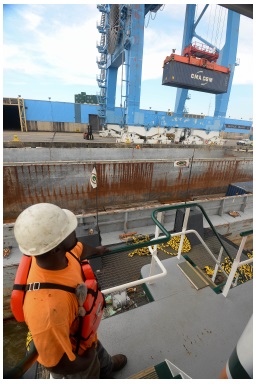Shipping Service: Baton Rouge/New Orleans, Wilmington (NC)
North Carolina’s Port of Wilmington Lure New Asia Container Service
The TP10/Amberjack all-water Asia/U.S. East Coast container service operated jointly by Maersk Line and Mediterranean Shipping Company (MSC) now includes North Carolina’s Port of Wilmington. Ten container vessels in the 4,300-5,100 TEU capacity range are deployed in the service, which made its Wilmington debut with the docking in early October of the SeaLand Lightning.
The TP10/Amberjack service links the U.S. East coast with the East Asian ports of Qingdao, Xingang, Ningbo, Shanghai and Busan via the Panama Canal.
"North Carolina has a ripe market that continues to drive the decisions of the world’s biggest container companies," said State Ports Authority Executive Director Paul J. Cozza. "Our inclusion in this rotation not only improves our visibility in international trade but also ensures the businesses that rely on us will have that much needed connection to Asia."
Maersk Line already deploys multiple strings into the Port of Wilmington via its Intra-Americas regional ocean carrier – SeaLand. SeaLand’s Atlantico and revised SAE services provide access to Latin America.
The TP10 announcement follows the recent return of intermodal rail service to the North Carolina Ports, the completion of the turning basin at the Port of Wilmington and the docking in Wilmington of its largest container ship ever, the 8,452-TEU Ever Laden.
The turning basin project entailed the removal of an existing bulk pier and dredging along the port’s side of the Cape Fear River to expand the turning basin from 1,200 feet to 1,400 feet. This expansion, says the ports authority, will typically accommodate vessels in the 8,000 to 10,000 TEU range, depending on the vessel’s profile.
Maritime Administration Grant to Aid Container-on-Barge Shuttle Service between Baton Rouge and New Orleans
The ports of New Orleans and Greater Baton Rouge will acquire specialized container loading equipment for the container-on-barge shuttle service operated by SEACOR AMH between Baton Rouge and New Orleans with a newly announced grant of $1.75 million from the U.S. Maritime Administration (MARAD).
"The container-on-barge service and the application for the MARAD grant have been joint projects for Baton Rouge and New Orleans, with both ports working together for more than a year," said Jay Hardman, executive director of the Port of Greater Baton Rouge.
Begun earlier this year with five barges per week, the regularly scheduled container-on-barge service transports export laden containers from the Baton Rouge area to the Port of New Orleans for loading onto ocean-going container ships.
The new service repositions empty containers from Memphis to Baton Rouge to accommodate the growing resin export trade. It also provides exporters with new transportation options and offers a waterway alternative for repositioning equipment that would otherwise move via truck or rail.
"We are thrilled to have received this grant and to be working with the Port of Greater Baton Rouge and SEACOR AMH to offer container-on-barge service to our customers," said New Orleans Port President Gary LaGrange, PPM®. "In addition to the economic and operational benefits, the service has a positive environmental impact, as well."
Data from a U.S. Department of Transportation study cited by the ports indicate a savings to the State of Louisiana of $118 per round-trip by moving a 40-foot container between New Orleans and Baton Rouge by barge rather than over the road.
SEACOR AMH, operator and developer of the shuttle service, and Ports America, the terminal operator at the Port of New Orleans and Port of Greater Baton Rouge, were also strategic partners in obtaining the grant.
The grant was awarded jointly to the two Louisiana ports and will be administered by the Port of Greater Baton Rouge.
It was one of six Marine Highway Program grants totaling $4.85 million announced October 26 by MARAD. Click here for the full listing.
"These grants will help us take advantage of the economic and environmental benefits of one of America’s most crucial transportation assets -- our coastal and inland waterways," said U.S. Department of Transportation Secretary Anthony Foxx.

Offloading a container from a SEACOR AMH barge at the Port of New Orleans’ Napoleon Avenue Container Terminal.
Photo/Port of New Orleans

